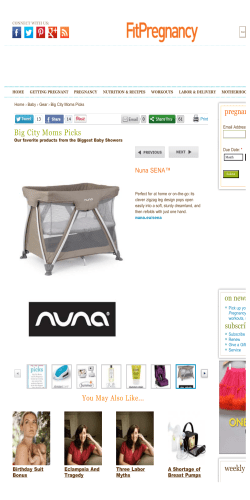
What Busy Moms Sneak Inâ¦TV Time
What Busy Moms Sneak In…TV Time Who knew moms were staying up so late? A6er months of research, the cable-‐TV network Nickelodeon has concluded that 9 p.m. to 1 a.m. are magical hours for moms, the Cme when they unwind a6er a long day of texCng, chauffeuring, managing schedules and being emoConally supporCve. Now, spotlighCng a shi6 in how women watch TV, Nick is beGng it can tap that market with new prime-‐Cme programming created by, about and for moms. Called "NickMom," it is the cable channel's effort to aLract more of an audience segment that is looking preLy hot to adverCsers these days. U.S. moms, in their dual roles as breadwinners and caregivers, spend an esCmated $2.1 trillion a year—up 24% since 1999—according to the Mom Complex, a think tank at adverCsing firm the MarCn Agency. And their spending is becoming especially apparent as a result of their avid use of social media. Nick is catering to an audience of women aged 40 and under, especially mothers who watched the channel when they were children. About 25% of mothers today watched Nick when they were kids, according to Nielsen. The cable channel is launching a website next week, where moms can interact. Programming in the works and set to start airing next fall may include a "Real Mom" reality show à la "Real Housewives," and a show called "Double Mom," where a comedian takes a mother's place for a day. Another idea is to air old episodes of "The Brady Brunch" with pop-‐up bubbles showing what Carol Brady and other characters were really thinking. The idea is to create content that "appeals to the sense of humor that mothers share," says Cyma Zarghami, president of Nickelodeon Networks. A6er decades in which TV programmers targeted mothers during the day, Nickelodeon's night-‐Cme strategy recognizes that many moms now work during the day and have leisure Cme late at night. Especially a6er Oprah Winfrey's syndicated dayCme talk show ended earlier this year, the NickMom effort highlights how women's dayCme viewing habits have changed, with many mothers watching recorded prime-‐ Cme shows during the day. Nickelodeon says the current generaCon of mothers consumes more media, including TV, movies and online content, than previous generaCons. "If you're the mother of a 2-‐year-‐old or a 17-‐year-‐old, you belong to an instant community. We thought we could tap into that," says Ms. Zarghami. Ms. Zarghami started at Nickelodeon in the mid-‐1980s as a clerk inpuGng data into program logs. She worked her way up and was named president in 2006. In that role, she stretched the Nickelodeon brand beyond its origins in programming for kids ages 2 to 11 by relaunching the "Nick Jr." channel for preschoolers and "TeenNick" for teens, and by partnering with Sony Music to create shows, like "Victorious," with musical content. "We don't want just to show cute babies in diapers, but rather capture those truly funny moments of motherhood," says Ms. Zarghami, who recalls how she tried puGng Cheerios in the toilet to help poLy train her sons. "When you're a mom, you set the bar very high and when you realize that other people are screwing up, too, it's such a relief," says Allison Pearson, author of the best-‐selling novel about mothering called "I Don't Know How She Does It," who is developing a feature for the "NickMom" website. In all, there are more than 30 NickMom projects in development, including talk shows, stand-‐up comedy, a game show called "Mom vs. Grandma," and a "Daily Show"–type news show anchored by comedian Annabelle Gurwitch. Five adverCsers including General Mills and ReckiL Benckiser intend to spend a total of $25 million to adverCse during the first NickMom season. "There is definitely an open space on television right now for programming featuring moms talking directly to other moms," says Mark Addicks, chief markeCng officer for General Mills. Ms. Zarghami, having given birth to three boys during her career at Nickelodeon, perceived the opportunity to cater to moms. She laid the groundwork by interviewing more than 100 mothers around the country. For a "deprivaCon study" called "Un-‐Mommed" that started this past summer, Nickelodeon paid 11 moms about $1,500 and put them up in a hotel for two nights while observing the effects on them and their families. The company set up cameras in the hotel and the families' houses, and it fiLed each family with biometric bands to test stress levels. All contact between mother and family, whether by phone, email, text or Facebook, was forbidden. This turned out to be very difficult for most moms, and was in some cases a dealbreaker —to the point where Nickelodeon had trouble filling the 11 slots. Among the study's preliminary findings were that mothers see their roles inside and outside the home as fluid; they "do not recognize a 'non-‐mom' part of their idenCCes," the study found. Another finding was that for both mothers and fathers, home life tends to cause more stress than work life; "the stakes are higher, so the stress is greater," the study found. It also revealed that mothers struggled to be "truly present" and to live in the moment. "NickMom" arrives in a marketplace where female-‐focused cable channels already crowd the dial. Women made up 70% of the prime-‐Cme audiences of for cable channels Bravo, E!, LifeCme, the Hallmark Channel, and TLC. Moms ages 18 to 49 also are the fuel for much of the big broadcast networks' prime-‐Cme fare, whether it's "American Idol," "2 Broke Girls" or "Dancing With the Stars." Among mothers between the ages of 18 and 49, Nickelodeon ranks as the most-‐watched cable channel. One advantage Nickelodeon has is current viewing paLerns, where mothers (and fathers) tend to watch TV with their children. "Co-‐viewing," as the industry calls it, rates on Nick Jr. have grown to 61% this year from 55% of its programming in 2009, according to Nielsen data provided by the network. Moreover, Nick Jr.'s total audience has grown by 23% since 2009, while the audience for Nickelodeon—which airs the hit franchises "SpongeBob" and "iCarly," has remained mostly flat. Sales are growing for all these foods: Coconut water, quinoa, kale, avocados, gluten-‐ free bread and Pop-‐Tarts. More typical rivals of the sugary breakfast-‐ snack food are seeing sales drop. "NickMom" programming won't be profitable the first year, Ms. Zarghami says. The newest generaCon of mothers is older, more diverse, tech-‐savvy and tech-‐ dependent, and TV execuCves are racing to tailor programming to their tastes. AdverCser spending on TV and across other media aimed at mothers reaches into the billions of dollars a year, according to the Mom Complex think tank. Marketers have even begun referring to the "mommy tsunami." "A lot of companies have suddenly woken up over the past couple of years and realized how much money moms are responsible for spending," says Stephanie Azzarone, president of Child's Play CommunicaCons, which helps connect marketers of products and services with mothers.
© Copyright 2026










